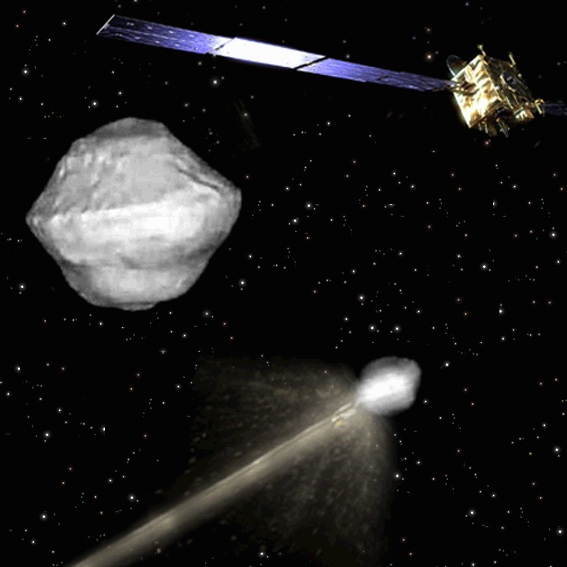
A mission that aims to slam a spacecraft into a near-Earth asteroid now officially has a target — a space rock called Didymos.
The joint European/U.S. Asteroid Impact and Deflection Assessment mission, or AIDA, will work to intercept Didymos in 2022, when the space rock is about 6.8 million miles (11 million kilometers) from Earth, European Space Agency officials announced Friday (Feb. 22).
Didymos is actually a binary system, in which a 2,625-foot-wide (800 meters) asteroid and a 490-foot (150 m) space rock orbit each other. Didymos poses no threat to Earth in the foreseeable future.
The proposed asteroid-smashing AIDA mission will send one small probe crashing into the smaller asteroid at about 14,000 mph (22,530 kph) while another spacecraft records the dramatic encounter. Meanwhile, Earth-based instruments will record so-called "ground-truthing" observations.
The goal is to learn more about how humanity could ward off a potentially dangerous space rock. The necessity of developing a viable deflection strategy was underlined in many people's minds by the events of last Friday (Feb. 15), when the 130-foot (40 m) asteroid 2012 DA14 gave Earth a historically close shave just hours after a 55-foot (17 m) object exploded above the Russian city of Chelyabinsk, injuring 1,200 people and damaging thousands of buildings.
The AIDA impact will unleash about as much energy as that released when a big piece of space junk hits a satellite, researchers said, so the mission could also help improve models of space-debris collisions.
"The project has value in many areas, from applied science and exploration to asteroid resource utilization," Andy Cheng, AIDA lead at Johns Hopkins University's Applied Physics Laboratory, said in a statement.
Breaking space news, the latest updates on rocket launches, skywatching events and more!
The European Space Agency (ESA) has asked scientists around the world to propose experiments that AIDA could carry in space or that could increase its scientific return from the ground. Researchers have until March 15 to pitch their ideas.
Johns Hopkins’ Applied Physics Laboratory is providing AIDA's impactor, which is called DART (short for Double Asteroid Redirection Test). The observing spacecraft is known as AIM (Asteroid Impact Monitor) and will come from ESA.
Follow SPACE.com senior writer Mike Wall on Twitter @michaeldwall or SPACE.com @Spacedotcom. We're also on Facebook and Google+.

Join our Space Forums to keep talking space on the latest missions, night sky and more! And if you have a news tip, correction or comment, let us know at: community@space.com.

Michael Wall is a Senior Space Writer with Space.com and joined the team in 2010. He primarily covers exoplanets, spaceflight and military space, but has been known to dabble in the space art beat. His book about the search for alien life, "Out There," was published on Nov. 13, 2018. Before becoming a science writer, Michael worked as a herpetologist and wildlife biologist. He has a Ph.D. in evolutionary biology from the University of Sydney, Australia, a bachelor's degree from the University of Arizona, and a graduate certificate in science writing from the University of California, Santa Cruz. To find out what his latest project is, you can follow Michael on Twitter.
